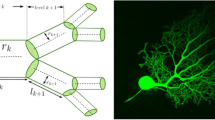Abstract
ALL our sensations, all our movements, most of the activities of our nervous system, depend upon a certain transmitted disturbance which we call the nervous impulse: this, in the study of nerve activity, is what the atom, the electron and the quantum are to chemistry and physics. A rapid reaction to events occurring at a distance is necessary for efficient working. Special nerve cells, therefore, have been developed in all the larger animals: from these the axon or nerve fibre runs out, which is only 3 μ to 25 μ in diameter but may be many metres in length. Along these fibres wave-like messages are sent.
This is a preview of subscription content, access via your institution
Access options
Subscribe to this journal
Receive 51 print issues and online access
$199.00 per year
only $3.90 per issue
Buy this article
- Purchase on Springer Link
- Instant access to full article PDF
Prices may be subject to local taxes which are calculated during checkout
Similar content being viewed by others
Rights and permissions
About this article
Cite this article
HILL, A. The Physical Nature of the Nerve Impulse*. Nature 131, 501–508 (1933). https://doi.org/10.1038/131501a0
Issue Date:
DOI: https://doi.org/10.1038/131501a0
This article is cited by
-
Der gegenwärtige Stand des mitogenetischen Problems
Protoplasma (1937)
-
Mitogenetic Radiation and Bioluminescence
Nature (1934)
-
Neuere Untersuchungen über den Nervenaktionsstrom
Ergebnisse der Physiologie und Experimentellen Pharmakologie (1934)
-
Neuere Untersuchungen über den Nervenaktionsstrom
Ergebnisse der Physiologie und Experimentellen Pharmakologie (1934)
-
Action of Quaternary Ammonium Salts on Nerve
Nature (1933)
Comments
By submitting a comment you agree to abide by our Terms and Community Guidelines. If you find something abusive or that does not comply with our terms or guidelines please flag it as inappropriate.



